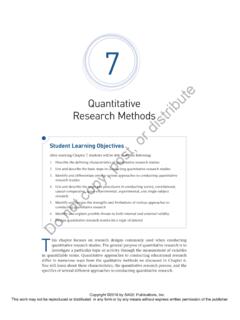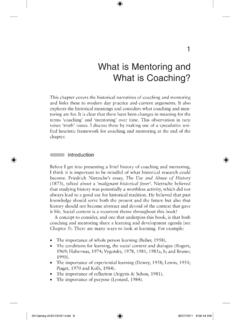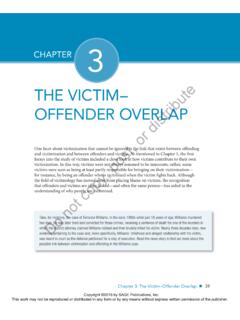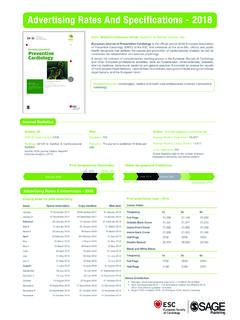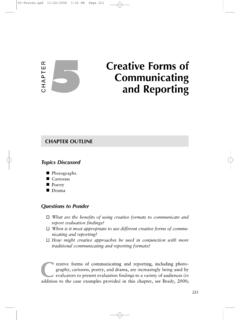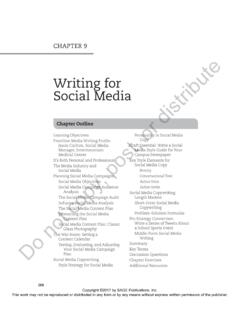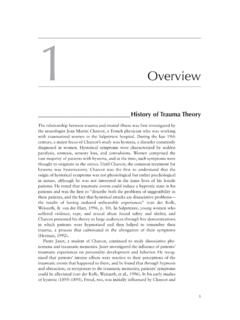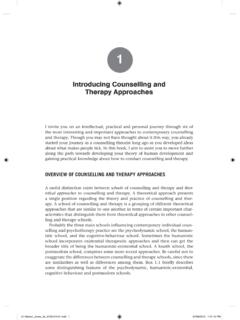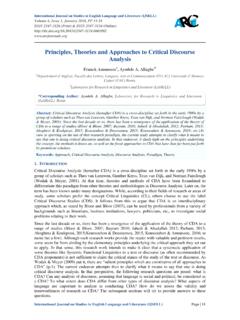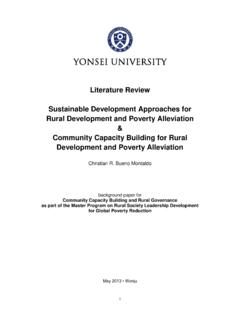Transcription of Comparing the Five Approaches - SAGE Publications Inc
1 Chapter 4 Five Qualitative Approaches to Inquiry 103with providing illustrative examples that we can continue to curtail such practices. Case study research has experienced growing recognition during the past 30 years, evidenced by its more frequent application in published research and increased avail-ability of reference works ( , Thomas, 2015; Yin, 2014). Encouraging the use of case study research is an expressed goal of the editors of the recent Encyclopedia of Case Study Research (Mills, Durepos, & Wiebe, 2010). Engaging researchers are a focus of a number of Publications aimed at guiding those new to the approach ( , Baxter & Jack, 2008; Flyvbjerg, 2006). Comparing the Five ApproachesAll five Approaches have in common the general process of research that begins with a research problem and proceeds to the questions, the data, the data analysis and interpretations, and the research report.
2 Qualitative researchers have found it helpful to see at this point an overall sketch for each of the five Approaches . From these sketches of the five Approaches , we can identify fundamental differences among these types of qualitative research. Finally, we compare the five Approaches relating the dimensions of foundational considerations (Table ), data procedures (Table ), and research reporting (Table ). In Table , we present four dimensions for distinguishing among the founda-tional considerations for the five Approaches . At a most fundamental level, the five differ in what they are trying to accomplish their foci or the primary objectives of the studies. Exploring a life is different from generating a theory or describing the behavior of a cultural group. A couple of potential similarities among the designs should be noted. Narrative research, ethnography, and case study research may seem similar when the unit of analysis is a single individual.
3 True, one may approach the study of a single individual from any of these three Approaches ; however, the types of data one would collect and analyze would differ considerably. In narrative research, the inquirer focuses on the stories told from the individual and arranges these stories often in chronological order; in ethnography, the focus is on setting the individuals stories within the context of their culture and culture-sharing group; in case study research, the single case is typically selected to illustrate an issue, and the researcher compiles a detailed description of the setting for the case. Our approach is to recommend if the researcher wants to study a single individual the narra-tive approach or a single case study because ethnography is a much broader picture of the culture. Then when Comparing a narrative study and a single case to study a single individual, we feel that the narrative approach is seen as more appropriate because narrative studies tend to focus on a single individual whereas case studies often involve more than one case.
4 The process of developing research question(s) can often be helpful for determining the suitability of the research problem for a specific approach. Moreover, although overlaps exist in discipline origin, some Approaches have single-disciplinary traditions ( , grounded theory originating in sociology, ethnography founded in anthropology or sociology), and others have broad interdis-ciplinary backgrounds ( , narrative, case study).Copyright 2018 by SAGE Publications , Inc. This work may not be reproduced or distributed in any form or by any means without express written permission of the not copy, post or Qualitative Inquiry and Research DesignThe Approaches employ similar data collection processes, including, in varying degrees, interviews, observations, documents, and audiovisual materials (see Table ). The differences are apparent in terms of emphasis ( , more observations in ethnog-raphy, more interviews in grounded theory) and extent of data collection ( , only interviews in phenomenology, multiple forms in case study research to provide the in-depth case picture).
5 At the data analysis stage, the differences are most pronounced. Not only is the distinction one of specificity of the analysis phase ( , grounded the-ory most specific, narrative research less defined) but the number of steps to be under-taken can vary ( , extensive steps in phenomenology, fewer steps in ethnography).The research reporting of each approach, the written report, takes shape from all the processes before it (see Table ). Stories about an individual s life comprise TABLE l Contrasting Foundational Considerations of Five Qualitative ApproachesFoundational ConsiderationsNarrative ResearchPhenomenologyGrounded TheoryEthnographyCase StudyResearch focus of approachExploring the life of an individualUnderstanding the essence of the experienceDeveloping a theory grounded in data from the fieldDescribing and interpreting a culture-sharing groupDeveloping an in-depth description and analysis of a case or multiple casesUnit of analysisStudying one or more individualsStudying several individuals who have shared the experienceStudying a process, an action, or an interaction involving many individualsStudying a group that shares the same cultureStudying an event, a program, an activity.
6 Or more than one individualType of research problem best suited for approachNeeding to tell stories of individual experiencesNeeding to describe the essence of a lived phenomenonGrounding a theory in the views of participantsDescribing and interpreting the shared patterns of culture of a groupProviding an in-depth understanding of a case or casesNature of disciplinary originsDrawing from the humanities including anthropology, literature, history, psychology, and sociologyDrawing from philosophy, psychology, and educationDrawing from sociologyDrawing from anthropology and sociologyDrawing from psychology, law, political science, and medicineCopyright 2018 by SAGE Publications , Inc. This work may not be reproduced or distributed in any form or by any means without express written permission of the not copy, post or 4 Five Qualitative Approaches to Inquiry 105 TABLE l Contrasting Data Procedures of the Five Qualitative ApproachesData ProceduresNarrative ResearchPhenomenologyGrounded TheoryEthnographyCase StudyForms of data collection Using primarily interviews and documentsUsing primarily interviews with individuals, although documents, observations, and art may also be consideredUsing primarily interviews with 20 to 60 individualsUsing primarily observations and interviews but perhaps collecting other sources during extended time in fieldUsing multiple sources, such as interviews, observations, documents, and artifactsStrategies of data analysis Analyzing data for stories, restor ying stories, and developing themes.
7 Often using a chronologyAnalyzing data for significant statements, meaning units, textual and structural description, and description of the essence Analyzing data through open coding, axial coding, and selective codingAnalyzing data through description of the culture-sharing group and themes about the groupAnalyzing data through description of the case and themes of the case as well as cross-case themesnarrative research. A description of the essence of the experience of the phenomenon becomes a phenomenology. A theory, often portrayed in a visual model, emerges in grounded theory, and a holistic view of how a culture-sharing group works results in an ethnography. An in-depth study of a bounded system or a case (or several cases) becomes a case study. The general structures of the written report may be used in designing a journal-article-length study. However, because of the numerous steps in each, they also have applicability as chapters of a dissertation or a book-length work.
8 We discuss the differences here because the reader, with an introductory knowledge of each approach, now can sketch the general architecture of a study within each approach. Certainly, this architecture will emerge and be shaped differently by the conclusion of the study, but it provides a framework for the design issues to follow. For each approach, the introduction describes the particular focus of the research and common across the Approaches , the introduction tends to familiarize the reader to the research problem and research question(s). The research procedures are subsequently outlined, often including a rationale for use of the approach and details related to the data procedures for the the unique organizing framework related to each approach and specifically the variations in how the research outcomes can be presented. Providing in-depth Copyright 2018 by SAGE Publications , Inc.
9 This work may not be reproduced or distributed in any form or by any means without express written permission of the not copy, post or Qualitative Inquiry and Research Designdescriptions is common across all the Approaches , but how the descriptions are orga-nized varies; whereas narrative research might use a chronology for telling stories, a phenomenology may use significant statements as the organizing structure for report-ing how the phenomenon was experienced. Similarly, how a research report concludes also varies by the approach; whereas it is common practice for a closing vignette in a case study, a cultural portrait is commonly used in an ethnography referring to overall interpretations, lessons learned, and questions raised representing the essence. These structures should be considered as general templates at this time. In Chapter 5, we will examine five published journal articles, with each study illustrating one of the five Approaches , and further explore the writing structure of l Contrasting Research Reporting of Five Qualitative ApproachesResearch ReportingNarrative ResearchPhenomenologyGrounded TheoryEthnographyCase StudyIntroduction of written reportFocusing on participant(s) and nature of the storyFocusing on explaining the phenomenonFocusing on the process (or action)
10 That the theory is intended to explain Focusing on the culture-sharing group being studied Using entry vignette and then focusing on central features of the case Description of research proceduresStating the rationale, significance of individual to experiences, and data proceduresStating the rationale, philosophical assumptions, and data proceduresStating the rationale and data proceduresStating the rationale, type, and data proceduresStating the rationale, type, and data proceduresOrganization of research outcomesTelling stories using a variety of ways involving restorying, theorizing, and narrative segmentsReporting how the phenomenon was experienced using significant statements and discussing meaning of themes Developing theory involving open coding categories, axial coding, selective coding, theoretical propositions, and a modelDescribing the culture and analyzing patterns of cultural themes with verbatim quotesProviding first extensive description of the case followed by key issues (themes or issues) in the case Concluding formatInterpreting patterns of meaningDescribing the essence of the experienceAdvancing a theory and Describing how a culture-sharing group works using a cultural portraitMaking case study assertions and advancing a closing vignetteCopyright 2018 by SAGE Publications , Inc.
